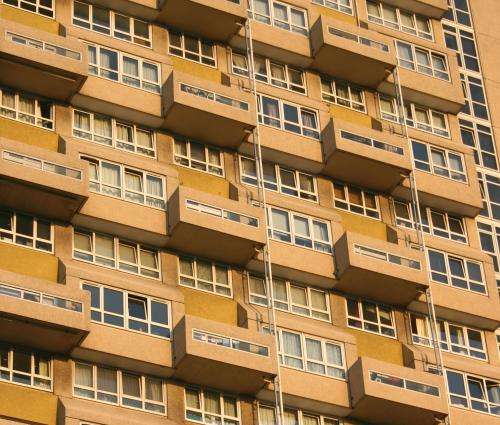(Phys.org) —While low-income families often choose multifamily housing for its affordability, a new University of Arizona study finds they could be spending hundreds more in utility costs every year due to a lack of energy-efficient features in their buildings.
The study, published in the September 2014 issue of the journal Building Research & Information, reports that in 2009, multifamily units – apartments in buildings with five or more units – occupied by low-income renters had 4.7 fewer energy efficient features, such as double-paned windows and Energy Star appliances, compared with other households.
Low-income apartment renters could potentially save $200 to $400 every year if the efficiency of their homes were on par with other housing types.
According to the study, energy inefficiency is one reason why energy spending per square foot in rented apartments has run 76 percent higher than in owner-occupied single-family homes in recent years. Other factors include the tendency for apartment renters to live more densely per room and to conserve less when landlords pay the utilities.
"It's hard enough for low income families to afford basic food, childcare, and transportation expenses, so it's important to know that money they might otherwise have for those needs is being wasted by inefficient heating and cooling systems and appliances," said Gary Pivo, a professor of Natural Resources and a professor of urban planning at the UA, who conducted the study. "Moreover, this 'energy efficiency gap' appears to be growing larger."
According to the study, some of the energy-efficient features multifamily rentals lack include programmable thermostats, adequate insulation, upgraded windows and eco-friendly appliances like washers, dryers, water heaters, furnaces and air conditioners.
Pivo said the reason for the deficiency is multifold.
First, more than 11 million rented apartments have subpar efficiency and government programs are not designed to retrofit anything close to that many units, Pivo said. Secondly, building owners are reluctant to pay for energy upgrades when tenants are the ones who would see lower energy bills.
In a 2011 consumer expenditure survey, the U.S. Bureau of Labor Statistics reported that home energy accounts for 17 percent of housing costs for households earning below the national median income, versus 13 percent for families living above it. If multifamily rental buildings were retrofitted with energy-efficient features, Pivo said families could use those savings to pay for food, health care and other essentials.
For example, converting an older heating system to a modern one could save $87 per year, in 2014 dollars, according to estimates provided in the study. Programmable thermostats could save families $114 per year, while upgrading units with Energy Star-qualified appliances including refrigerators, washing machines and dishwashers, could amount to savings up to $97 per year.
The savings for renters can add up quickly, but upgrades to the millions of apartments in the U.S. would be costly. According to Pivo, funding from organizations like the HUD Multifamily Energy Innovation Fund or the Fannie Mae Green Refinance Plus program and equity investors could be an option, though more evidence needs to be compiled that helps private real estate investors see how efficiency retrofits can benefit their bottom line.
"It is frustrating that more private investment is not going into efficiency retrofitting," Pivo said. "Unfortunately, there's a lack of good information on the private financial risks and opportunities and that must be addressed before investors will move capital into retrofitting on a very large scale."
Pivo also said that unequal access to energy efficient housing is not only an economic issue. It has health, social equity and environmental impacts as well. He said addressing energy efficiency in multifamily rentals would come with a suite of benefits for the U.S.
"Building energy-efficiency retrofitting is one of the most cost-effective ways we know of for reducing global warming and it creates green jobs," he said. "It works all across the triple bottom line – for people, profits and planet."
Provided by University of Arizona





















